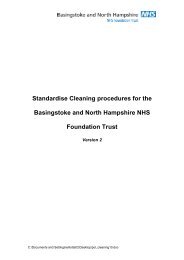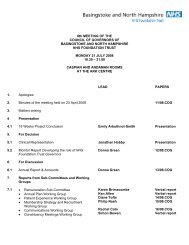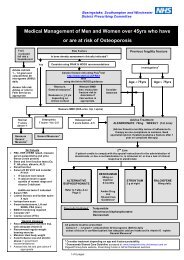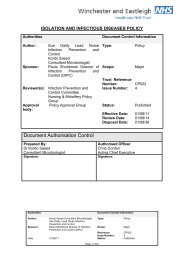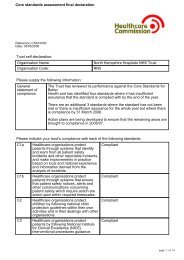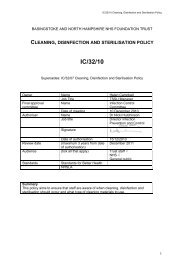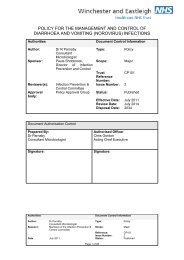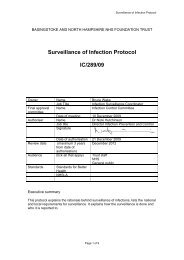purchasing and supplies strategy 2008 - Hampshire Hospitals NHS ...
purchasing and supplies strategy 2008 - Hampshire Hospitals NHS ...
purchasing and supplies strategy 2008 - Hampshire Hospitals NHS ...
You also want an ePaper? Increase the reach of your titles
YUMPU automatically turns print PDFs into web optimized ePapers that Google loves.
PURCHASING AND SUPPLIES STRATEGY<br />
<strong>2008</strong> – 2010<br />
Owner Name Tammie Purdue<br />
Job Title<br />
Final approval<br />
committee<br />
Name<br />
Head of Purchasing &<br />
Supplies<br />
Date of meeting<br />
Authoriser Name Mary Edwards<br />
Job title<br />
Chief Executive<br />
Signature<br />
Date of authorisation<br />
Review date (maximum 3 years from July 2009<br />
date of authorisation)<br />
Audience (tick all that apply) Trust staff<br />
<strong>NHS</strong><br />
SUMMARY<br />
The purpose of the Purchasing <strong>and</strong> Supplies Strategy is to create <strong>and</strong> embed a<br />
vision <strong>and</strong> aim for the direction of <strong>purchasing</strong> at Basingstoke <strong>and</strong> North<br />
<strong>Hampshire</strong> <strong>NHS</strong> Foundation Trust.<br />
The Basingstoke <strong>and</strong> North <strong>Hampshire</strong> <strong>NHS</strong> Foundation Trust has developed<br />
this Purchasing <strong>and</strong> Supplies Strategy in line with the relevant legislation <strong>and</strong><br />
guidelines. Its implementation will ensure a consistent, automated <strong>and</strong><br />
successful approach to all <strong>purchasing</strong> carried out by the Trust.<br />
This <strong>strategy</strong> applies to all individuals in the employ of Basingstoke <strong>and</strong> North<br />
<strong>Hampshire</strong> <strong>NHS</strong> Foundation Trust.<br />
v3.1 1
Table of Contents<br />
Page<br />
1. EXECUTIVE SUMMARY 3<br />
2. INTRODUCTION 4<br />
3. BACKGROUND 4<br />
4. CURRENT SITUATION 4<br />
5. PROCUREMENT STRATEGY 5<br />
6. STRATEGIC AIMS 5<br />
6.1. Business Case Development 5<br />
6.2. Supplier Selection 6<br />
6.3. Qualification <strong>and</strong> Tendering 6<br />
6.4. Contract Awards 6<br />
6.5. Contract Management 7<br />
6.6. Supplier Performance/Management 7<br />
6.7. Supplier/Product Rationalisation 7<br />
6.8. Product St<strong>and</strong>ardisation 8<br />
6.9. Collaborative Purchasing <strong>and</strong> Contracting 8<br />
6.10. Materials Management 8<br />
6.11. Stock Management 8<br />
6.12. Receipt & Distribution – Internal Logistics 9<br />
6.13. Purchase to Pay Systems 9<br />
6.14. Value for Money 10<br />
6.15. Compliance 10<br />
7. EQUALITY AND DIVERSITY 10<br />
8. SUSTAINABLE DEVELOPMENT 11<br />
8.1. Environmental Issues 11<br />
9. RESPONSIBILITY 11<br />
9.1 Trust Board Level 11<br />
9.2 Divisional Level 11<br />
9.3 Purchasing <strong>and</strong> Supplies Department 11<br />
10. COMMUNICATION 12<br />
11. IMPLEMENTATION 12<br />
APPENDIX ONE – ACTION PLAN 14<br />
v3.1 2
1. Executive Summary<br />
The purpose of this <strong>strategy</strong> is to positively influence <strong>purchasing</strong> <strong>and</strong> supply across<br />
Basingstoke <strong>and</strong> North <strong>Hampshire</strong> <strong>NHS</strong> Foundation Trust (BNHFT) <strong>and</strong> to support<br />
departments <strong>and</strong> wards in delivering high quality healthcare to patients using best value<br />
<strong>and</strong> best practice.<br />
This <strong>strategy</strong> has been developed to address the total supply chain for the Trust <strong>and</strong><br />
provides a strategic vision including the following key components:<br />
• Best value <strong>and</strong> best practice<br />
• To deliver savings recurring as a contributent to annual business<br />
planning<br />
• To automate <strong>purchasing</strong> <strong>and</strong> supply processes ensuring efficiency<br />
• To satisfy compliance to legal <strong>and</strong> regulatory requirements<br />
• To optimise stock levels by efficient management <strong>and</strong> control<br />
• To promote <strong>and</strong> drive supplier <strong>and</strong> product rationalisation<br />
The full benefits from this <strong>strategy</strong> will come from the commitment <strong>and</strong> priority given by the<br />
Board <strong>and</strong> through positive support <strong>and</strong> contribution from wards <strong>and</strong> departments. The<br />
outcomes are summarised as follows:<br />
• An integrated team concept which provides flexible resourses more efficiently.<br />
• Improved commercial performance, best procurement practice <strong>and</strong> minimal<br />
process costs to deliver best value.<br />
• Automated systems enabling the <strong>supplies</strong> department to develop its business<br />
<strong>and</strong> trading relationships with improved management information facilitating<br />
optimum procurement strategies<br />
• Adaptable to changing needs in a dynamic business <strong>and</strong> healthcare environment<br />
through effective management <strong>and</strong> control. Common solutions to shared<br />
problems will emerge as a result.<br />
• Planned <strong>and</strong> organised approach to all trust <strong>purchasing</strong> <strong>and</strong> <strong>supplies</strong><br />
requirements<br />
“The Supplies Team aims to become a centre of excellence for all <strong>purchasing</strong> through the<br />
promotion <strong>and</strong> implementation of proactive best value procurement in support of innovative<br />
high quality services to all our customers, <strong>and</strong> to lead on this through the professional skills<br />
<strong>and</strong> competence of all staff involved.”<br />
v3.1 3
2. Introduction<br />
The Trust recognises that the proper management of <strong>purchasing</strong> <strong>and</strong> <strong>supplies</strong> is essential<br />
to the efficiency <strong>and</strong> effectiveness of clinical <strong>and</strong> support services. This document outlines<br />
a <strong>strategy</strong> for procurement <strong>and</strong> supply management, which is in line with the Trust’s<br />
strategic direction <strong>and</strong> business plan objectives.<br />
This document outlines a 3-year <strong>strategy</strong> <strong>and</strong> follows on from the previous <strong>strategy</strong> dated<br />
March 2003.<br />
3. Background<br />
This <strong>strategy</strong> incorporates a whole spectrum of activities, which can be described as part of<br />
the total supply chain of the Trust. This <strong>strategy</strong> will identify these activities but will also set<br />
out the objectives of, <strong>and</strong> responsibility for, each of them within the Trust. This <strong>strategy</strong><br />
also acknowledges that this activity will be rooted in the Trust’s strategic direction <strong>and</strong><br />
business planning objectives <strong>and</strong> be seen as a vital contribution to its success.<br />
This <strong>strategy</strong> also acknowledges that the Trust is part of a very complex set of networks of<br />
manufacturers, suppliers <strong>and</strong> a range of other stakeholders, including the wider <strong>NHS</strong>, <strong>and</strong><br />
therefore sets out the Trust’s expectations including identification of strategic <strong>and</strong><br />
collaborative options.<br />
4. Current Situation<br />
Over the past few years the Trust has recognised that <strong>purchasing</strong> <strong>and</strong> supply functions are<br />
key in ensuring value for money for the <strong>purchasing</strong> of goods <strong>and</strong> services. Historically the<br />
procurement function of the Trust had been organised primarily at a clerical level via the<br />
Supplies department.<br />
Since the introduction of the Procurement Strategy in 2003 a number of changes have<br />
taken place, which has led to this service modernising <strong>and</strong> becoming more strategic:<br />
• In 2005 the <strong>supplies</strong> department installed an integrated <strong>purchasing</strong> system allowing<br />
electronic ordering <strong>and</strong> connecting directly to the Trust Finance system.<br />
• In 2006 a contracts database <strong>and</strong> contracting team were implemented<br />
• Since 2006 annual contracting <strong>and</strong> savings plans have been developed<br />
• In 2007 the department was integrated into the Finance structure<br />
• In 2007 the department restructured to ensure the new structure supported the move to<br />
Foundation Trust <strong>and</strong> engaged the shift from clerical level to strategic level working<br />
v3.1 4
This <strong>strategy</strong> leads on from these developments <strong>and</strong> builds on the previous procurement<br />
<strong>strategy</strong> <strong>and</strong> is intended to cover the supply of all goods <strong>and</strong> services required by the Trust<br />
to enable high quality health care services.<br />
5. Procurement Strategy<br />
This <strong>strategy</strong> is intended to cover the procurement <strong>and</strong> supply of all goods <strong>and</strong> services<br />
required by the trust. Procurement <strong>and</strong> Supply Management covers a spectrum of activity<br />
including:<br />
• Business Case development<br />
• Supplier selection<br />
• Qualification <strong>and</strong> tendering<br />
• Contract awards<br />
• Contract Management<br />
• Supplier performance/management<br />
• Supplier/product Rationalisation<br />
• Product st<strong>and</strong>ardisation<br />
• Collaborative Purchasing <strong>and</strong> Contracting<br />
• Materials Management/Stock Management<br />
• Receipt <strong>and</strong> distribution – internal logistics<br />
• Purchase to pay systems<br />
• Value for money<br />
• Compliance<br />
All of these are encapsulated within this <strong>strategy</strong>.<br />
6. Strategic Aims<br />
6.1 Business Case Development<br />
As a Foundation, the trust is responsible for the management of its finances <strong>and</strong> has the<br />
opportunity to re-invest any surplus achieved back into the organisation. However,<br />
investments into large purchases need to be planned <strong>and</strong> funding allocated within sufficient<br />
timescales.<br />
Historically procurement processes have been omitted from business cases <strong>and</strong> therefore<br />
the right <strong>purchasing</strong> choice has often been difficult <strong>and</strong> value for money not always<br />
achieved. With the new European Union (EU) legislation surrounding tendering it is<br />
becoming more difficult to waive these processes <strong>and</strong> therefore procurement needs to be<br />
integral to all business cases involving <strong>purchasing</strong>.<br />
Aim: to ensure business cases are provided for all major procurements to enable<br />
full life cost analysis to be captured <strong>and</strong> ensure value for money<br />
v3.1 5
6.2 Supplier Selection<br />
Historically the selection of suppliers has often been based on previous procurements <strong>and</strong><br />
no supplier evaluation or market analysis has been carried out to ensure optimal capability<br />
<strong>and</strong> best value. New EU legislation provides the following general principles:<br />
• All procurements should be subject to competition<br />
• All procurements should be conducted on a value for money basis<br />
• All procurements should be fair, open <strong>and</strong> transparent<br />
All procurements need to take account of previous procurements so as not to view the<br />
purchase in isolation, especially when dealing with goods or services, which are similar or<br />
have effects on the clinical environment for which the items or services are required.<br />
Aim: to ensure all purchases above tender value are advertised in order to adhere<br />
to the general principles of the new EU Legislation<br />
6.3 Qualification <strong>and</strong> Tendering<br />
Qualification is concerned with identifying those suppliers who are qualified to provide the<br />
services required by the <strong>NHS</strong>. That could be supplying a service or a product. PASA (The<br />
Purchasing <strong>and</strong> Supply Agency) set up a Supplier Information Database (SID) which is free<br />
for all <strong>NHS</strong> Organisations <strong>and</strong> which holds vital information on suppliers used throughout<br />
the <strong>NHS</strong>. This is therefore essentially a vetted, approved supplier list. This list of approved<br />
suppliers is used as an aid to calling for competition, approving c<strong>and</strong>idates <strong>and</strong> expediting<br />
the selection of tenderers. However, the information held in this database is often out of<br />
date or vital information is missing <strong>and</strong> therefore individual organisations are still required to<br />
obtain information against each individual tendering exercise.<br />
Since the development of the SID system many other electronic procurement system<br />
providers have also developed similar databases.<br />
Tendering is a very paper intensive process <strong>and</strong> under the new EU directives must be<br />
transparent. A st<strong>and</strong>ard set of documentation is already used for all tenders <strong>and</strong> there are<br />
now systems available to provide suppliers with the documentation electronically. These<br />
systems usually include supplier accreditation services as well as electronic opening<br />
procedures to ensure it meets Trusts St<strong>and</strong>ing Financial Instructions (SFIs).<br />
Aim: to seek <strong>and</strong> recruit an electronic tendering system to include alternative<br />
supplier accreditation service for use with all future tendering exercises.<br />
6.4 Contract Awards<br />
Under new EU directives all contracts, following the issue of the successful <strong>and</strong> unsuccessful<br />
letters, should have an 11-day st<strong>and</strong>still period allowing the unsuccessful<br />
bidders to seek clarification or debriefing. Bidders can now bring litigation if these<br />
processes are not followed or if the process has not been transparent. It is also m<strong>and</strong>atory<br />
following the st<strong>and</strong>still period <strong>and</strong> within 48 days to issue a contract award notice via the<br />
official journal. It is therefore very important to ensure all paperwork or electronic<br />
documentation relating to the tender is held centrally.<br />
v3.1 6
Aim: to hold a complete evidence base of all tendering paperwork either electronic<br />
or paper<br />
6.5 Contract Management<br />
Historically contracts have been put in place with little or no on-going management behind<br />
them. Contract management is a crucial reason for user dissatisfaction <strong>and</strong> for not<br />
realising value for money. It is important to have continuity in the relationship <strong>and</strong> for<br />
contract managers from both the Trust <strong>and</strong> the supplier to have been engaged early in the<br />
procurement process.<br />
With a dedicated contracts database <strong>and</strong> contracting team now in place contract<br />
management has improved for the Trust but needs to be built in to the st<strong>and</strong>ard<br />
procedures.<br />
Aim: to monitor all contracts on a regular basis for the duration of the contract <strong>and</strong><br />
ensure contract management is written into st<strong>and</strong>ard procedures<br />
6.6 Supplier Performance/Management<br />
Historically suppliers have been able to continuous fail to provide the service we require,<br />
usually by not delivering to the correct address, not delivering on time, not using the<br />
appropriate order numbers etc. This increases the trusts administration time both for<br />
<strong>supplies</strong> staff <strong>and</strong> clinical staff <strong>and</strong> therefore has a cost associated with it. In order to<br />
reduce this cost a supplier performance procedure needs to be adopted within <strong>supplies</strong> to<br />
monitor those suppliers who regularly fail to follow the procedures. This will increase the<br />
control over suppliers <strong>and</strong> enable a more seamless process for receiving goods.<br />
Aim: to implement a supplier performance system that records evidence of<br />
suppliers performance <strong>and</strong> which can be reported on a regular basis<br />
6.7 Supplier/Product Rationalisation<br />
The Trust currently has in excess of 2500 suppliers. Best practice advises that supplier<br />
reduction programmes are extremely powerful for delivering cost savings <strong>and</strong> improved<br />
customer service. Consolidating business with key suppliers <strong>and</strong> utilising their ability to<br />
source from non-key suppliers cuts administrative overheads <strong>and</strong> enables procurement<br />
functions to focus on achieving significant added value for the business.<br />
In all stages of the order cycle a wide range of operational <strong>and</strong> administrative savings will<br />
result from an effective supplier reduction program. Purchase requisition generation,<br />
expediting, delivery, stores management, internal delivery, payment <strong>and</strong> payment queries<br />
are all areas where administrative cost reductions will be seen.<br />
Aim: where appropriate to develop <strong>and</strong> implement a supplier reduction programme<br />
v3.1 7
6.8 Product St<strong>and</strong>ardisation<br />
Product st<strong>and</strong>ardisation is the process by which clinical products are reviewed to evaluate<br />
how they work <strong>and</strong> to consider their cost. It removes the fragmented <strong>and</strong> uncoordinated<br />
approach to product choice that can occur in <strong>NHS</strong> settings. It moves product selection to<br />
user led rather than supplier led, improves quality to patients, achieves costs savings <strong>and</strong><br />
encourages users to work together on choosing products rather than each department<br />
working autonomously.<br />
Aim: where appropriate to increase product st<strong>and</strong>ardisation throughout the trust<br />
6.9 Collaborative Purchasing <strong>and</strong> Contracting<br />
The <strong>NHS</strong> has long recognised the benefits of collaborative procurement, stretching back<br />
over a number of decades. This followed successive reports on the subject, particularly<br />
around national, regional <strong>and</strong> area contracting. Modernising <strong>NHS</strong> Supply saw the<br />
development <strong>and</strong> establishment of <strong>NHS</strong> collaborative procurement organisations<br />
coterminous with Strategic Health Authority (SHA) boundaries, known as supply<br />
management confederations <strong>and</strong> more recently as hubs.<br />
The Trust has chosen not to join the local hub known as ‘Pro-cure’ which represents the<br />
Thames Valley <strong>and</strong> <strong>Hampshire</strong> & Isle of Wight area. A number of organisations such as<br />
Basingstoke have opted out of using this route <strong>and</strong> these are:<br />
• Reading (Royal Berkshire <strong>and</strong> Battle Foundation Trust)<br />
• Solent Supplies Department (servicing Portsmouth <strong>and</strong> IOW)<br />
Therefore Basingstoke, Reading <strong>and</strong> Solent have been working together on a few selected<br />
contracts.<br />
Aim: to continue to work collaboratively with other Trusts in similar situations to<br />
ours<br />
6.10 Materials Management<br />
Materials Management is the process managed by <strong>supplies</strong> to ensure wards or<br />
departments have the essential items ‘topped up’ on a weekly basis. The process is very<br />
much governed by the supplier ‘<strong>NHS</strong> Supply Chain’ <strong>and</strong> therefore the team work to certain<br />
procedures to ensure stock is managed effectively. The Materials Managers work closely<br />
with clinical staff <strong>and</strong> more recently with housekeepers who play a vital part in this role.<br />
This aids the team in knowing when stocks may fluctuate <strong>and</strong> results in less products being<br />
over or under stocked.<br />
Aim: to optimise stock levels by efficient management <strong>and</strong> control <strong>and</strong> by building<br />
relationships with clinical staff at ward level<br />
6.11 Stock Management<br />
Stock Management is not all h<strong>and</strong>led by the <strong>supplies</strong> department. Many departments are<br />
responsible for managing their stationery stock <strong>and</strong> some areas are too small to use the<br />
v3.1 8
materials management system. Fundamentally all areas across the trust should be looking<br />
at more appropriate methods for ordering their stock <strong>and</strong> some of the solutions available<br />
are advised by Supplies, for example., consolidating orders. Unfortunately this is not seen<br />
as priority across departments <strong>and</strong> therefore areas either hold too much stock, too little<br />
stock or order too frequently <strong>and</strong> this imposes unnecessary cost to the Trust.<br />
Aim: implement training schemes or communications throughout the trust<br />
demonstrating best practise stock management<br />
6.12 Receipt <strong>and</strong> Distribution – Internal Logistics<br />
The Receipt <strong>and</strong> Distribution team are responsible for the internal logistics for all goods<br />
arriving through the main stores at BNHFT. Although the purchase order system allows<br />
goods to be receipted electronically the internal delivery notes which are signed by the user<br />
department are still paper based. A large amount of time is therefore spent h<strong>and</strong>ling paper.<br />
It is also evident that the workflow through this area has increased somewhat, especially<br />
with regards to 18 weeks <strong>and</strong> it is becoming increasingly difficult to manage every parcel<br />
with the control it needs.<br />
There are a number of bar-coded delivery systems which would improve the process for<br />
delivering goods internally, by making goods more secure <strong>and</strong> by ensuring the signatures<br />
are recorded <strong>and</strong> held electronically for future reference. This would remove administration<br />
time <strong>and</strong> cost.<br />
Aim: to invest in systems for controlling goods received into the hospital in order to<br />
provide more security <strong>and</strong> reduce unnecessary cost<br />
6.13 Purchase to Pay Systems<br />
Currently the trust uses an e-procurement solution provided by Cedar. Although this<br />
provides some of the purchase to pay process electronically there is still a substantial<br />
amount, which is keyed in manually. A purchase to pay system is an e-commerce solution<br />
that automates trade between buyers <strong>and</strong> suppliers from requisitioning through to invoicing.<br />
It maximises trading connections, transaction volumes <strong>and</strong> savings.<br />
In easier terms it allows suppliers to manage our specific products electronically <strong>and</strong> allows<br />
requisitioners to ‘punch-out’ from our current Cedar solution, pick the products they need<br />
<strong>and</strong> then pull them back into our purchase order. In other words ‘shopping on-line’. The<br />
order is then electronically transmitted direct to that supplier <strong>and</strong> they can then<br />
electronically transmit the invoice directly to our system.<br />
A Purchase to Pay system will remove process costs <strong>and</strong> approximately 60% of manual<br />
input for invoicing. The system allows the speed of order process through to delivery to be<br />
improved substantially. It also helps to ensure a transparent service <strong>and</strong> provides better<br />
management information with regards to the product usage <strong>and</strong> spend. The other benefit<br />
is it will allow the trust to implement one system for all rather than other areas using their<br />
own system for purchase orders i.e., catering, pharmacy.<br />
Aim: to invest in a purchase to pay system <strong>and</strong> streamline the ordering systems<br />
used within the Trust<br />
v3.1 9
6.14 Value for Money<br />
Value for money is important but is not just made up of price. It includes total acquisition<br />
<strong>and</strong> supply cost. Value for money is achieved by using competition, aggregating dem<strong>and</strong>,<br />
establishing long term contracts, maximising discounts <strong>and</strong> reviewing usage <strong>and</strong> spend on<br />
a regular basis. It also looks at the back end costs such as process or transaction costing.<br />
Aim: to improve value for money by competition, aggregation, commitment,<br />
improved planning <strong>and</strong> prompt payment<br />
6.15 Compliance<br />
Compliance with the rules <strong>and</strong> regulations surrounding <strong>purchasing</strong> is essential in ensuring<br />
best value <strong>and</strong> best practise. In large organisations it is often too easy for individuals to bypass<br />
the correct procedures <strong>and</strong> therefore undermine the work which has been<br />
implemented to ensure value for money. This causes unnecessary costs to the Trust.<br />
The Trust has st<strong>and</strong>ard financial procedures, which include St<strong>and</strong>ing Orders (SO’s) <strong>and</strong><br />
St<strong>and</strong>ing Financial Instructions (SFI’s). These documents detail the levels of spend <strong>and</strong><br />
the process that needs to be followed including the approval level <strong>and</strong> everyone within the<br />
trust has a duty to comply with these instructions. However many staff throughout the trust<br />
are not advised of these <strong>and</strong> unfortunately these documents are not specific enough to the<br />
<strong>purchasing</strong> processes.<br />
Aim: to develop <strong>and</strong> implement a <strong>purchasing</strong> policy to support (SO’s) <strong>and</strong> (SFI’s)<br />
7. Equality <strong>and</strong> Diversity<br />
Equality <strong>and</strong> Diversity matters for the <strong>NHS</strong> <strong>and</strong> new legislation requires the <strong>NHS</strong> to meet<br />
certain duties to promote this in <strong>and</strong> through procurement. It is central to <strong>NHS</strong><br />
Organisations playing their role as a good corporate citizen.<br />
The Trust needs to be ethical in how it procures <strong>and</strong> this includes our relationship with the<br />
Suppliers. Any individual or group contracted to provide services on behalf of the trust<br />
needs to demonstrate that they operate in accordance with the requirements of race<br />
equality, disability equality <strong>and</strong> gender equality. It needs to be a condition of any tendering<br />
process for suppliers to demonstrate equality <strong>and</strong> fairness <strong>and</strong> the award <strong>and</strong> continuation<br />
of a contract needs to be contingent upon operating a policy conducive to meeting the<br />
contractual commitment to co-operate with the trust in meeting its obligations within the<br />
three equality duties.<br />
This <strong>strategy</strong> supports this <strong>and</strong> has included our duties for equality <strong>and</strong> diversity within the<br />
action plan.<br />
v3.1 10
8. Sustainable Development<br />
The <strong>NHS</strong> plays a key role in contributing to Sustainable Development through its significant<br />
annual procurement expenditure. The <strong>NHS</strong> Purchasing <strong>and</strong> Supply Agency is responsible<br />
for implementing the government’s agenda <strong>and</strong> has made recommendations in support of<br />
this for individual trusts to pursue.<br />
8.1 Environmental Issues<br />
Under the Treaty of Amsterdam the EU is committed to the integration of its environmental<br />
policies into all of its others, including procurement. <strong>NHS</strong> organisations are required to<br />
address environmental issues within their procurement activity. There are a number of<br />
ways the Trust can support this: -<br />
• Engagement of small <strong>and</strong> medium sized enterprises (SMEs), black <strong>and</strong><br />
other minority enterprises (BMEs) – which includes disabled-owned<br />
businesses, women-only businesses <strong>and</strong> social enterprises <strong>and</strong> voluntary<br />
sector businesses.<br />
• Working with suppliers to reduce waste through packaging<br />
• Working with suppliers to reduce carbon emissions through the<br />
aggregation of deliveries<br />
This <strong>strategy</strong> intends to support these <strong>and</strong> plans to include these within its tendering <strong>and</strong><br />
contracting procedures.<br />
9. Responsibility<br />
9.1 Trust Board Level<br />
The Director of Finance has board level executive responsibility for the procurement <strong>and</strong><br />
<strong>supplies</strong> function within the Trust <strong>and</strong> will be accountable for ensuring the implementation<br />
of this <strong>strategy</strong>. In addition, the Director of Finance will provide periodic reports to the<br />
Board on the progress made against this <strong>strategy</strong>.<br />
9.2 Divisional Level<br />
The Divisional Managers of each Division will be responsible for ensuring that their staff<br />
engage effectively in all procurement <strong>and</strong> <strong>supplies</strong> processes in accordance with this<br />
<strong>strategy</strong>. They will also engage staff to participate in the delivery of the objectives laid<br />
down in this <strong>strategy</strong> <strong>and</strong> will continue to monitor the work of their staff in achieving this.<br />
9.3 Purchasing <strong>and</strong> Supplies Department<br />
The Head of Purchasing <strong>and</strong> Supplies will be responsible for this <strong>strategy</strong> <strong>and</strong> ensuring the<br />
successful implementation of all the objectives. The Head of Purchasing <strong>and</strong> Supplies will<br />
v3.1 11
develop close links with Divisional Managers <strong>and</strong> Divisional Finance <strong>and</strong> Performance<br />
Managers to ensure the implementation <strong>and</strong> on-going progress is monitored appropriately.<br />
10. Communication<br />
Following approval by the Corporate <strong>and</strong> Supports Service Governance Board this <strong>strategy</strong><br />
will be communicated to the Divisional Governance Boards. It will then be passed to the<br />
Corporate Governance Board for final approval before being communicated to the wider<br />
organisation.<br />
11. Implementation<br />
The attached appendix outlines the objectives for the <strong>purchasing</strong> <strong>and</strong> <strong>supplies</strong> department<br />
<strong>and</strong> details the individual actions, responsibility <strong>and</strong> timescale for completion.<br />
v3.1 12
v3.1 13
No. Strategic Aim Actions Target<br />
Timescale<br />
6.1 Business Case Development • Work with Divisional Managers<br />
/General Managers to ensure<br />
business cases are provided for<br />
major procurements<br />
6.2 Supplier Selection • Ensure advertising of all<br />
tenders<br />
• Update procedures to include<br />
6.3 Qualification <strong>and</strong> Tendering • Review current paper<br />
procedures for tendering<br />
• Examine electronic tender <strong>and</strong><br />
supplier accreditation systems<br />
• Produce business case<br />
6.4 Contract Awards • Ensure complete evidence<br />
base of all tendering <strong>and</strong><br />
contracting paperwork<br />
6.5 Contract Management • Ensure all contracts have<br />
regular reviews built in<br />
• Update procedures to include<br />
contract management<br />
• Record data on contracts <strong>and</strong><br />
hold evidence for future<br />
6.6 Supplier Performance/Management • Develop <strong>and</strong> implement<br />
supplier performance database<br />
• Develop st<strong>and</strong>ard reports on<br />
information held<br />
6.7 Supplier Rationalisation • Develop <strong>and</strong> implement<br />
supplier rationalisation<br />
programme<br />
v3.1 14<br />
Responsibility<br />
• Head of Purchasing<br />
<strong>and</strong> Supplies<br />
• Divisional Managers<br />
• General Managers<br />
• Procurement Lead<br />
• Head of Purchasing<br />
<strong>and</strong> Supplies<br />
• Head of Purchasing<br />
<strong>and</strong> Supplies<br />
• Procurement Lead<br />
• Procurement Lead<br />
• Procurement Lead<br />
• Procurement Lead
• Reduce suppliers by 5% per<br />
year for next 3 years<br />
6.8 Product Rationalisation • Increase rationalisation of<br />
products across the trust<br />
• Increase st<strong>and</strong>ardisation<br />
• Produce list of st<strong>and</strong>ard<br />
products for information<br />
purposes<br />
6.9 Collaborative Purchasing <strong>and</strong><br />
Contracting<br />
• Continue to link with other<br />
trusts for benchmarking<br />
purposes<br />
• Continue to work collaboratively<br />
6.10 Materials Management • Optimise stock levels<br />
• Develop closer relationships<br />
with clinical staff/housekeepers<br />
• Improve the management <strong>and</strong><br />
control of stock<br />
6.11 Stock Management • Implement training programme<br />
to increase users knowledge of<br />
stock <strong>and</strong> stock control systems<br />
used<br />
6.12 Receipt & Distribution – Internal • Examine goods received<br />
Logistics<br />
electronic systems<br />
• Produce business case<br />
6.13 Purchase to Pay Systems • Examine purchase to pay<br />
systems<br />
• Produce business case<br />
• Streamline ordering systems<br />
6.14 Value for Money • Aggregate <strong>and</strong> plan dem<strong>and</strong><br />
where possible<br />
• Encourage competition<br />
• Encourage commitment to<br />
suppliers by longer term<br />
v3.1 15<br />
• Supply Chain Lead<br />
• Procurement Lead<br />
• Head of Purchasing<br />
<strong>and</strong> Supplies<br />
• Head of Purchasing<br />
<strong>and</strong> Supplies<br />
• Supply Chain Lead<br />
• Supply Chain Lead<br />
• Head of Purchasing<br />
<strong>and</strong> Supplies<br />
• Head of Purchasing<br />
<strong>and</strong> Supplies<br />
• Head of Purchasing<br />
<strong>and</strong> Supplies<br />
• Procurement Lead<br />
• Supply Chain Lead
contracts<br />
• Examine preferential payment<br />
opportunities<br />
• Provide cash releasing <strong>and</strong> cost<br />
avoidance savings for<br />
procurements of £500K per<br />
year for next 3 years<br />
6.15 Compliance • Improve compliance with<br />
<strong>purchasing</strong> procedures<br />
• Develop <strong>and</strong> implement<br />
<strong>purchasing</strong> policy<br />
• Develop <strong>and</strong> implement desk<br />
guides<br />
7.0 Equality <strong>and</strong> Diversity • Build into procurement policy<br />
• Review diversity of supplier<br />
base<br />
• Include in tendering <strong>and</strong><br />
contracting procedures<br />
• Include in contract<br />
management process<br />
8.1 Environmental Issues • Engagement of small <strong>and</strong><br />
medium sized enterprises<br />
(SMEs), <strong>and</strong> other minority<br />
enterprises (BMEs)<br />
• Work with suppliers to reduce<br />
waste through packaging<br />
• Work with suppliers to reduce<br />
carbon emissions through the<br />
aggregation of deliveries<br />
• Procurement Lead<br />
• Divisional Managers<br />
• General Managers<br />
• Procurement Lead<br />
<strong>and</strong> Head of<br />
Purchasing <strong>and</strong><br />
Supplies<br />
• Head of Purchasing<br />
<strong>and</strong> Supplies<br />
• Procurement Lead<br />
• All Trust staff who<br />
receive goods <strong>and</strong><br />
services<br />
v3.1 16



